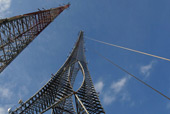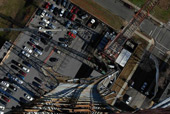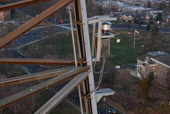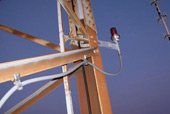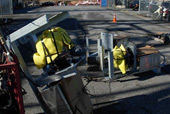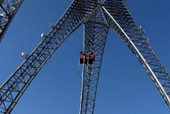High-Intensity Dual Lighting Installation
In order to replace an old, high-intensity LED lighting system with a Flash Technology system featuring LED Red lights, we incorporated rigging and lifting to install the system safely in an urban setting. The planning, staging, and execution of this project was complex, due to the wide number of clients involved-as a result, we worked at night to minimize down time for active broadcast stations.
Rigging included 6-ton blocks, steel chokers, a Man Basket, and a Man-rated hoist with 3,000 feet of 3/8" steel wire rope. A 2,200-foot synthetic rope was also required. All work was carried out with preparation for extreme weather conditions, and daily meeting and inspections were performed on all equipment and rigging. Trial lifts were conducted and the fall zone was constantly monitored.
The load line was rigged up the center of the 700-foot tower, and ran down the exterior where it was attached to a trolley train. Static lines allowed for access to difficult locations, including hot-zone applications and back leg mounting. This rigging system ultimately enabled the proper installation of various light fixtures, including beacons and marker lights, as well as custom designed and manufactured steel mounts and attachment hardware. Extensive conduit runs, both rigid and flexible, were also installed.
Specifications:
| Capabilities Applied/Processes | The lighting replacement was done incorporating rigging and lifting techniques in order to install the system in an urban setting in a professional and safe manner. |
|---|---|
| Equipment Used to Remove/Install Lighting Fixtures, Mounts & Conduit | An array of rigging including 6 ton blocks, steel chokers, Man Basket and a Man rated hoist with 3000 foot of 3/8 steel wire rope. Various lengths of other synthetic ropes including a 2200 foot length were incorporated. |
| Overall Tower Size and Type | 700' Self Supporting Adephon Tower |
| Construction Methods | A comprehensive rigging plan was incorporated to allow us to access the tower in a safe and efficient manner. The load line was rigged up the center of the tower and then ran down the outside at which point a trolley line was incorporated. Riding up and down the tower removing the old lighting and installing the new system using various lengths of rope to secure and guide the basket. Static lines were also incorporated to overcome difficult access points including mounting to the back leg and hot zone applications. |
| Logistics | Coordination with the owner, the local government and various clients to accommodate our installation, including planning, staging, and executing a "Hot Zone" replacement which involved working at 700' at night to allow minimal time lost for the broadcast stations affected. Considerations were needed for the weather including high winds, snow and extreme cold. |
| Materials Worked With | Various lighting fixtures including beacons and marker lights. Steel mounts and attachment hardware. Extensive conduit runs including both rigid and flexible conduit. 700' of vertical wire runs and various horizontal runs including runs which had to cross at the top of the "tear drop" and go 100' down the back legs to reach the lower marker lights. |
| In process Inspections performed | Tailgate meetings were held every morning before work would begin. Daily inspections would be performed on all of our equipment including PPE and all of the rigging equipment. A trial lift was performed with the man basket. Our fall zone perimeter was also monitored constantly. |
| Fabrication | Custom mounts including small foot pedestals were designed and built to accommodate the existing attachment points without having to make additional holes in the legs. |
| Industry for Use | This tower has many clients including: Government, Broadcasters, cellular and two way communication entities |
| Installation Location | Washington, DC |
| Standards Met | Working with Flash Technology to provide a system which would meet our installation needs and FAA regulations. |
| Completion Time | 7 weeks |

